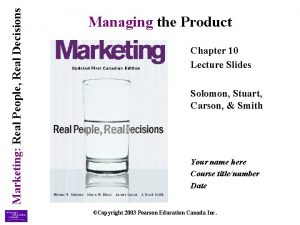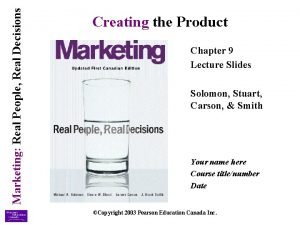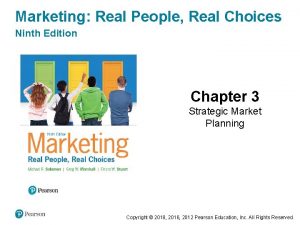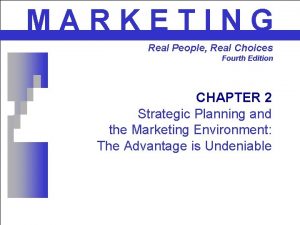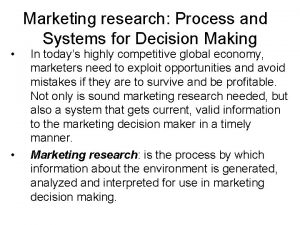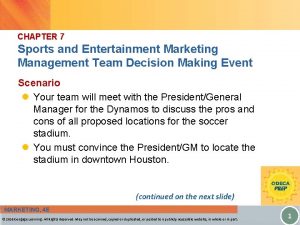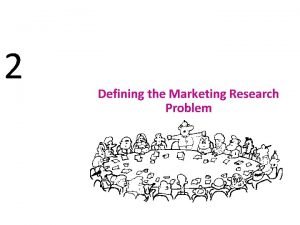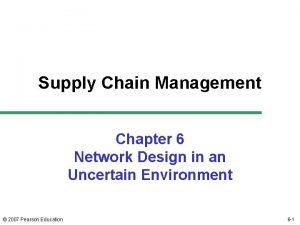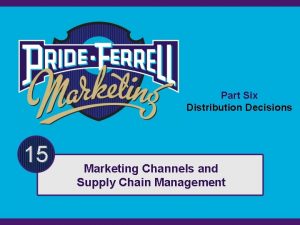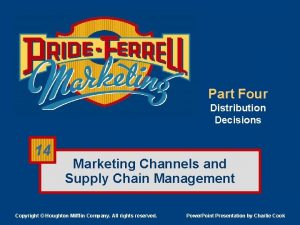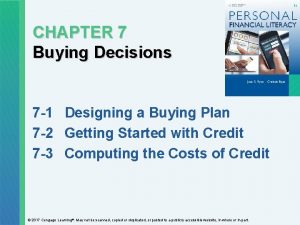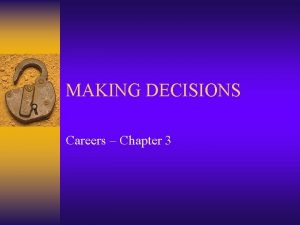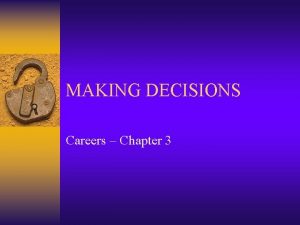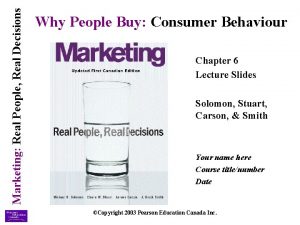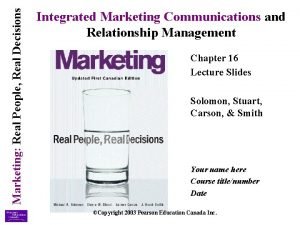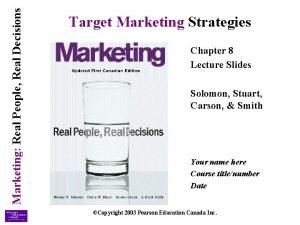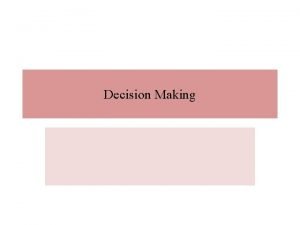Marketing Real People Real Decisions Decision Making in





















- Slides: 21

Marketing: Real People, Real Decisions Decision Making in the New Era of Marketing Chapter 3 Lecture Slides Solomon, Stuart, Carson, & Smith Your name here Course title/number Date ©Copyright 2003 Pearson Education Canada Inc.

Marketing: Real People, Real Decisions Chapter Learning Objectives When you have completed your study of this chapter, you should be able to: • Explain why organizations have adopted a New Era marketing focus on ethics and social responsibility • Describe the New Era emphasis on quality • Discuss some of the important aspects of an organization’s internal environment. • Explain why marketers scan an organization’s external business environment. ©Copyright 2003 Pearson Education Canada Inc. 2

Marketing: Real People, Real Decisions Introduction to the Topic • Social profit: the benefit an organization and society receive from the organization’s ethical practices, community service, efforts to promote cultural diversity, and concern for the natural environment. • Many organizations have come to recognize that the value of doing the right thing goes beyond the short term public relations benefits that may be gained. • But what does “doing the right thing” mean in an organizational context? Figure 3. 1 ©Copyright 2003 Pearson Education Canada Inc. 3

Marketing: Real People, Real Decisions Ethical Behaviour in the Marketplace • Business ethics: rules of conduct for an organization. These are the basic values that guide a firm’s behaviour. • The difference between what is right and wrong is a very subjective thing, which is why there is so much variation in this area. • Code of ethics: written standards of behavior to which everyone in the organization must subscribe. • “The fish stinks from the head” would suggest that employees take their direction from senior managers when considering ethical issues. • Shareholder’s rights, and the behaviour of senior management has come under intense media scrutiny in early 2002, for good reason. ©Copyright 2003 Pearson Education Canada Inc. 4

Marketing: Real People, Real Decisions AMA Code of Ethics • The American Marketing Association (AMA) publishes a code of ethics for marketers on its web site, which consists of four different categories of responsibilities. • To accept responsibility for the consequences of their activities • To not knowingly do harm • To adhere to all applicable laws and regulations • Be honest and fair in all dealings with consumers, clients, employees, suppliers, distributors, and the public. • Avoid participation in conflict of interest situations without prior notice to all parties involved. ©Copyright 2003 Pearson Education Canada Inc. 5

Marketing: Real People, Real Decisions Consumerism: Fighting Back • Consumerism: a social movement that attempts to protect consumers from harmful business practices. • The Consumers’ Association of Canada (CAC) was created to inform, educate, and advocate on behalf of consumers. • Their seven (plus one) consumer rights are: – The right to safety – The right to be informed – The right to be heard – The right to redress – The right to choose – The right to a healthy environment – The right to a consumer education – The right to privacy ©Copyright 2003 Pearson Education Canada Inc. 6

Marketing: Real People, Real Decisions Ethics in the Marketing Mix • Product safety is an important issue to protect consumers from harm or loss due to defective or dangerous products. Safety standards for products are established and monitored by independent organizations such as the Canadian Standards Association (CSA). • Price fixing: an illegal business practice in which firms decide in advance on a common price for their product. • Price discrimination: charging lower prices to larger customers. This is legal when it can be shown that cost savings are available to the manufacturer or it is necessary to meet competitors’ pricing. • Price gouging: charging excessive prices in response to a high demand/low supply situation. ©Copyright 2003 Pearson Education Canada Inc. 7

Marketing: Real People, Real Decisions Ethics in the Marketing Mix (continued) • Product promotion can be a problem in terms of misleading or false advertising. The advertising industry in Canada is self-regulating through the Advertising Standards Canada (ASC). • Advertising to children and gender stereotyping are two areas of concern • Slotting allowance: a fee paid by a manufacturer to a retailer in exchange for agreeing to place products on the retailer’s shelves. • This is standard practice in the grocery trade, which has been aided by the widespread use of private label brands. • The danger is that consumers may not have access to the products of smaller manufacturers who cannot afford to pay these fees. ©Copyright 2003 Pearson Education Canada Inc. 8

Marketing: Real People, Real Decisions A Focus on Social Responsibility • Social responsibility: a management practice in which organizations seek to engage in activities that have a positive effect on society and promote the public good. • Environmental stewardship: a position taken by an organization to protect or enhance the natural environment as it conducts its business activities. • Green marketing: a marketing strategy that supports environmental stewardship by creating an environmentally founded differential benefit in the minds of consumers. • This effort has been hampered by a lack of consensus on what it means to be “green” ©Copyright 2003 Pearson Education Canada Inc. 9

Marketing: Real People, Real Decisions Serving Society and Community • Cause marketing: a marketing strategy in which an organization serves its community by promoting and supporting a worthy cause or by allying itself with a notfor-profit organization to tackle a social problem. • Consumers will respond to this if they believe the organization to be sincere. • Cultural diversity: a management practice that actively seeks to include people of different sexes, races, ethnic groups, and religions in organization’s employees, customers, suppliers, and distribution channel partners. ©Copyright 2003 Pearson Education Canada Inc. 10

Marketing: Real People, Real Decisions A Focus on Quality • Quality: The level of performance, reliability, features, safety, cost, or other product characteristics that consumers expect to satisfy their needs and wants. • The National Quality Institute surveys customers and companies on quality issues. • Total Quality Management (TQM): a management philosophy that focuses on satisfying customers through empowering employees to be an active part of continuous quality improvement. • ISO 9000: criteria developed by the International Standards Organization (ISO) to regulate product quality internationally. • The ISO 9000 program is administered in Canada by the Standards Council of Canada. ©Copyright 2003 Pearson Education Canada Inc. 11

Marketing: Real People, Real Decisions The Internal Business Environment • The internal environment of the organization includes its resources and competencies. • Corporate culture: the set of values, norms, and beliefs that are held by an organization’s managers and that influence that behavior of everyone in the organization. • Organizational culture will vary in its attitude towards risk taking, as well as individuality and creativity. • Organizations will also vary in their attitude towards the pursuit of profits versus satisfying the needs of stakeholders, such as employees, customers, suppliers, and the public. ©Copyright 2003 Pearson Education Canada Inc. 12

Marketing: Real People, Real Decisions The Internal Business Environment • Publics: groups of people- including suppliers, channel intermediaries, customers, employees, shareholders, financial institutions, government, the media, and public interest groups- that have an interest in an organization. • Competition within an industry can become destructive as intensity builds, as seen in the battle for the long distance market since de-regulation of this industry. • In the long run, nobody wins in a price war. Who wins in the short run? ©Copyright 2003 Pearson Education Canada Inc. 13

Marketing: Real People, Real Decisions The External Business Environment • The economic environment has a big influence on the success of an organization’s marketing strategy. • Business cycle: the overall patterns of change in the economyincluding periods of prosperity, recession, depression, and recoverythat affect consumer and business purchasing power. • Consumer confidence: an indicator of future spending patterns, measured by the extent to which people are optimistic or pessimistic about the state of the economy. • The concept of derived demand tells us that all economic activity is derived from sales at retail, which is why we keep track of consumer spending levels. ©Copyright 2003 Pearson Education Canada Inc. 14

Marketing: Real People, Real Decisions The Competitive Environment • Competitive intelligence (CI): the process of gathering and analyzing public information about rival firms. While still a relatively new concept to most firms, CI can assist decision makers in developing superior marketing strategies. • Competition within the microenvironment includes all product alternatives that a consumer may choose to spend their discretionary income on. • Discretionary income: the portion of income people have left over after paying for such necessities as housing, utilities, food, and clothing. • We can differentiate between types of competition. ©Copyright 2003 Pearson Education Canada Inc. 15

Marketing: Real People, Real Decisions Competition in the Micro. Environment • Product competition: very different products competing to satisfy the same consumer needs and wants. • Vacation resorts compete against cruise lines, bus tours, adventure tours, and RV camping to satisfy the need for relaxation. • Brand competition: similar products or services that compete based on the brand’s reputation or perceived benefits. • Brand names are used by consumers as an indicator of quality or positioning. • Successful brand names can use this equity to introduce new products that have a higher rate of acceptance due to their association with the brand. ©Copyright 2003 Pearson Education Canada Inc. 16

Marketing: Real People, Real Decisions Competition in the Macroenvironment • Monopoly: a market situation in which one firm, the only supplier of a particular product, is able to control the price, quality and supply of that product. • Oligopoly: a market structure in a which relatively small number of sellers, each holding a substantial share or the market, compete in a market with many buyers. • Monopolistic competition: a market structure in which may firms, each having slightly different products, offer consumer unique benefits. • Perfect competition: a market structure in which many small sellers, all of which offer similar products, are unable to have impact on the quality, price, or supply of a product. ©Copyright 2003 Pearson Education Canada Inc. 17

Marketing: Real People, Real Decisions The Technological Environment • Rapidly changing technology can create both opportunities and threats to organizations attempting to develop competitive marketing strategies. • Organizations may use their investment in technology as the basis of their competitive advantage, but this can be an ever-moving target. • Proprietary technology is a valuable asset for an organization and needs to be protected. • Patent: legal document granting an individual or firm exclusive right to produce and sell a particular invention. ©Copyright 2003 Pearson Education Canada Inc. 18

Marketing: Real People, Real Decisions The Legal Environment • The legal environment includes all laws-municipal, provincial, federal, and global-that affect businesses. Businesses ignore this area at their peril as some of their actions can pose serious risks of liability. • The main federal law governing business activity is the Competition Act, which is intended to promote competition and efficiency in the marketplace. • Other laws affecting business in Canada: – Consumer Packaging and Labelling Act – Food and Drug Act – Canadian Environmental Protection Act – Motor Vehicle Safety Act – Trade-marks Act – Tobacco Act ©Copyright 2003 Pearson Education Canada Inc. 19

Marketing: Real People, Real Decisions The Sociocultural Environment • An understanding of how social and cultural factors influence business activity is important to developing effective marketing strategies. • Marketers need to know what is happening to their target markets in terms of size and trends affecting them. • Demographics: statistics that measure observable aspects of population, including age, gender, ethnic group, income, education, occupation, and family structure. • North American culture in the past 50 years has been dominated by the influence of its skewed population distribution, also known as the Baby Boomers. ©Copyright 2003 Pearson Education Canada Inc. 20

Marketing: Real People, Real Decisions Famous Last Words… • The New Era of Marketing focuses on ethics and social responsibility. • Firms who subscribe to this philosophy consider economic and social profit as objectives to be achieved. • Decision makers in the New Era of Marketing need to monitor both their internal and external environments to identify trends that may affect their operations. ©Copyright 2003 Pearson Education Canada Inc. 21
 Marketing real people real decisions
Marketing real people real decisions Marketing real people real decisions
Marketing real people real decisions Poster making meaning
Poster making meaning Objectives of decision making
Objectives of decision making Financial decision
Financial decision Marketing: real people, real choices
Marketing: real people, real choices Marketing real people real choices
Marketing real people real choices Slidetodoc.com
Slidetodoc.com Screening decisions and preference decisions
Screening decisions and preference decisions How to improve marketing performance
How to improve marketing performance Role of marketing research
Role of marketing research Marketing research in decision making
Marketing research in decision making Sports and entertainment marketing team decision making
Sports and entertainment marketing team decision making Management decision problem and marketing research problem
Management decision problem and marketing research problem Decision tree supply chain
Decision tree supply chain Distribution decisions in marketing
Distribution decisions in marketing Multiple distribution channel
Multiple distribution channel Media strategy is making media decisions based on
Media strategy is making media decisions based on An organized method for making good buying decisions.
An organized method for making good buying decisions. Designing a buying plan
Designing a buying plan Making spatial decisions using gis
Making spatial decisions using gis Making healthy decisions unit test
Making healthy decisions unit test
